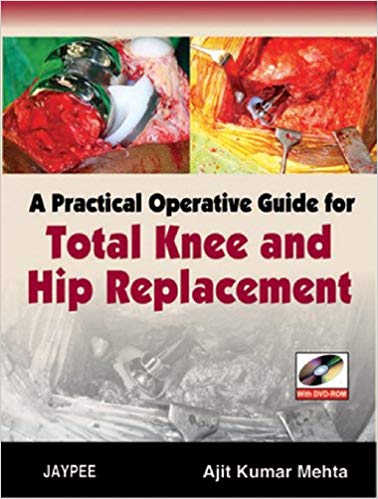
By Mehta
Hardcover: 232 pages
Publisher: Jaypee Brothers Medical Publishers (P) Ltd.; 1/E edition (December 31, 2008)
Language: English
ISBN-10: 8184482396
ISBN-13: 978-8184482393
In severe arthritis among the advanced age persons the painful and disabling knee and hip joints are required to be replaced. Its replacement provides relief from pain and disability and also helps to perform activities to a great extent with normally. It improves the quality of life significantly, but total knee and hip replacement surgeries are special operations. The surgeons require having highest order of aseptic precaution, surgical skill and a team specialists in preoperative, peroperative and postoperative techniques and protocols. This book fully explains step-by-step procedure and precautions to be observed in undertaking this kind of surgery. The operation theatre setup has been described. It describes postoperative management. The protocols and techniques of TKR surgeries are mentioned in sequential order. Technique of high tibial osteotomy by hemicallotasis using a dynamic axial fixator for isolated medial compartment osteoarthritis of knee has been mentioned in sequential order. 1. Introduction, 2. History and Clinical Examination, 3. Investigations, 4. Physiotherapy, education and Training, 5. Consent for surgery, 6. Patient and Relative’s signature for risk/benefit ratio, 7. Preoperative planning for TKR, 8. Arrangement of neurovascular structures around the knee, 9. Blood supply to the knee, 10. Tourniquet application, 11. Positioning, 12. Scrubbing, 13. Draping, 14. Incision, 15. Tibial cut, 16. Femoral cuts, 17. Resurfacing of patella, 18. Tibial preparation, 19. Cementing, 20. Application of tibial insert, 21. Wound closure, 22. Postoperative Advice, 23. Follow-up schedule, 24. Assessment during follow-up, 25. Total knee replacement (TKR) in difficult situations, 26. Post HTO TKR, 27. Important points, 28. Take care of (precautions to prevent peroperative complications), 29. Avoid silly mistake, 30. Contraindications of TKR, 31. Ideal indicated patients for successful TKR, 32. Complications, 33. Implants and cement required for primary TKR, 34. Summary of TKR (steps in sequence), 35. Instruments required for TKR, 36. Fixed bearing versus mobile bearing TKR (RPF), 37. Instruments required for RPF TKR, 38. Periprosthetic fracture, 39. Infection, 40. Knee arthrodesis with LRS in cases of infected TKR, 41. Aseptic loosening, 42. Revision TKR, 43. Implants required for revision TKR, 44. Instruments required for revision TKR, 45. OT Setup for Joint Replacement Surgery, 46. Introduction, 47. Vertical Laminar flow ventilation, 48. Prevention of infection, 49. Preoperative planning, 50. Positioning – Lateral position, 51. Draping, 52. Posterior approach, 53. Cemented THR (C-stem), 54. Features of Triple taper C-stem, 55. Bone cements, 56. Uncemented THR (Summit stem), 57. Combination in hip replacement, 58. Assessment during follow-up, 59. Instruments required for uncemented THR (Summit stem), 60. Implants and cement required for cemented THR (C-stem), 61. Implants required for uncemented THR (Summit stem), 62. Implants required for metal on metal, Articulating surface replacement (ASR), 63. Instruments required for metal on metal, ASR and Pinnacle, 64. Implants for metal on metal or ceramic on ceramic, Pinnacle cup and head, 65. different measurements of femoral stem, 66. Features of summit tapered hip system, 67. Important points, 68. Summary of THR (Steps in sequence for cemented and uncemented), 69. Proxima hip, 70. Proxima instruments, 71. Proxima implants.
Premium Content
Login to buy access to this content.What's Your Reaction?
Excited
0
Happy
0
In Love
0
Not Sure
0
Silly
0

